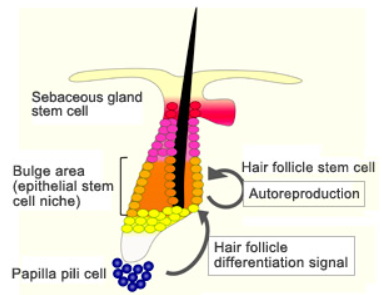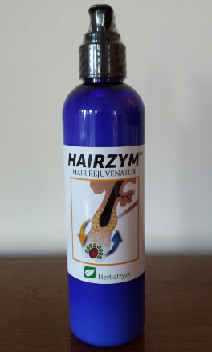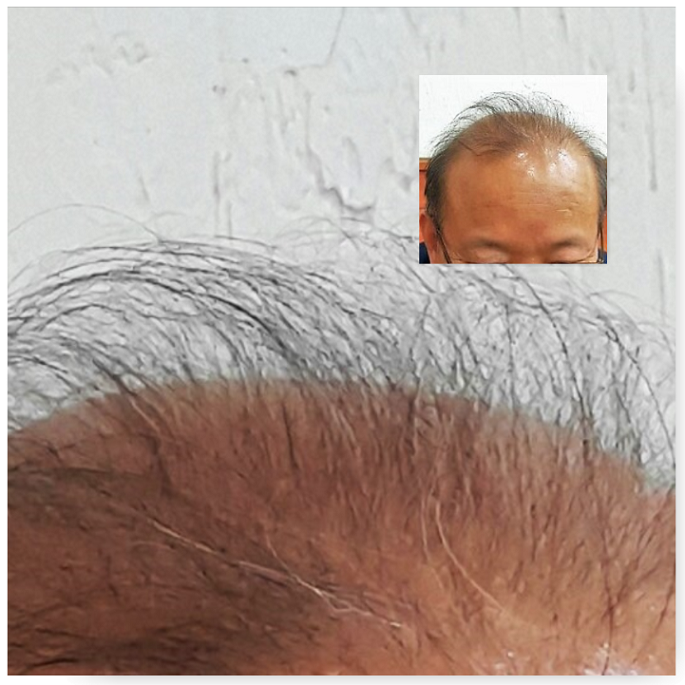Hair loss is mostly out of your control because baldness comes down to your genes. The experts say that 50 per cent of men have lost a significant amount of hair by the age of 50. Aging women have a similar problem. Their hair gets thin, although it’s not clear that this is necessarily caused by sex hormones. Losing hair is part of a normal cycle of growth and replacement. Hair follicles, the organs that create hair, go through the growth and resting cycle in a non synchronized fashion. But sometimes things go wrong. Hair follicles may become smaller due to the influence of androgenic hormones, and they may develop alopecia when they are destroyed by autoimmunity diseases or injury. So far, some treatment methods have become widespread, including drugs to inhibit the influence of androgens, and autologous transplantation of hair follicles in which hair follicles are removed from normal areas and transplanted to hair loss areas. However, these treatment technologies are not effective in all cases and cannot increase the number of healthy hair follicles.
Many people know that men can buy shampoo with an ingredient called minoxidil. Minoxidil (originally developed as Rogaine) fights androgenic alopecia in both men and women. Minoxidil basically aids in extending the growth phase of the hair since each one goes through a growth cycle and male pattern baldness hastens the process. The other currently approved drug for hair loss is Propecia (generic name, finasteride). It works only for men. Why? It keeps the male sex hormone testosterone from forming its DHT by-product. DHT signals shorten the growth phase — and lengthen the rest stage — of hormone-sensitive follicles. Side effects of Propecia can be loss of libido, difficulty in achieving an erection, and a decrease in the amount of semen. Minoxidil and Propecia are not a cure for hair loss. They will only work over the long term if you continue using them. If you stop using them you will likely lose any hair you have gained.
 Though a number of products and treatments currently exist to fight back against hair loss, a so-called permanent ”cure” would probably be one of the most exciting scientific discoveries to come along in a long time. The Holy Grail of hair-loss treatment is getting shutdown follicles to regenerate. At the base of the follicle is the hair bulb, where wildly growing matrix cells become hair. The hair follicle has stem cells. A little farther up the follicle is the mysterious feature called the bulge. That’s where follicle stem cells live. There are two types of stem cells that are responsible for the continuous renewal of the follicles. The first type is called active stem cells and they start dividing quite easily. Stem cells of the second type are called quiescent and in case of the new hair growth they don’t start dividing as easily. At the same time, the new hair is based primarily on quiescent cells, which attracted close attention of researchers to these cells.
Though a number of products and treatments currently exist to fight back against hair loss, a so-called permanent ”cure” would probably be one of the most exciting scientific discoveries to come along in a long time. The Holy Grail of hair-loss treatment is getting shutdown follicles to regenerate. At the base of the follicle is the hair bulb, where wildly growing matrix cells become hair. The hair follicle has stem cells. A little farther up the follicle is the mysterious feature called the bulge. That’s where follicle stem cells live. There are two types of stem cells that are responsible for the continuous renewal of the follicles. The first type is called active stem cells and they start dividing quite easily. Stem cells of the second type are called quiescent and in case of the new hair growth they don’t start dividing as easily. At the same time, the new hair is based primarily on quiescent cells, which attracted close attention of researchers to these cells.
At first people thought that baldness was due to the lack of this type of cells. However, recent studies showed that bald men did have those quiescent cells in their follicles. The problem was that they didn’t divide at all and didn’t contribute to forming new hairs. This means that even a bald person still has the potential to grow new hair, but because of lack of some regulatory factors quiescent cells can’t start replicating. The follicles are held in a quiescent state—one in which they don’t reproduce until they receive signals from their surroundings that it’s time to regenerate. When they get the right set of chemical signals, these self-renewing cells divide. They don’t divide like normal cells, in which both halves become new cells that keep splitting and developing. Only one half of the follicle stem cell does that. The other half becomes a new stem cell, and stays put for future regeneration. Apparently, It is all about hair stem cell environment.
A new study shows that FOXC1 protein is a key transcriptional regulator of hair follicle stem cell activity and bulge maintenance.
 One of the interesting conclusions of the article seems to imply that premature hair loss is also correlated with premature hair graying. Hair follicle stem cells influence the behavior of melanocyte stem cells, which co-inhabit the bulge niche. Thus, when the numbers of hair follicle stem cells declined with age, so too did the numbers of melanocyte stem cells, resulting in premature graying of whatever hairs were left.
One of the interesting conclusions of the article seems to imply that premature hair loss is also correlated with premature hair graying. Hair follicle stem cells influence the behavior of melanocyte stem cells, which co-inhabit the bulge niche. Thus, when the numbers of hair follicle stem cells declined with age, so too did the numbers of melanocyte stem cells, resulting in premature graying of whatever hairs were left.
Hairzym, a new topical hair loss product, is developed to protect stem cells and activate their metabolism to get energy for continuously producing new skin and hair cells and also activating hair follicles that are in the rest phase or damaged. Hairzym is a new revolutionary solution for activating quiescent stem cells and getting your hair back. And, it is the safest and smartest way to avoid prescription drugs and surgical hair transplantation. Clinical trials with Hairzym show that when applying Hairzym on the scalp it activates quiescent stem cells to grow new hair. This is where the uniqueness of Hairzym lies – it can activate damaged and passive stem cells that in turn activate passive hair bulbs to grow new and healthy hair.
Due to synergistic active compound combination in Hairzym, stem cells get the right set of chemical signals and enough energy to create new hair bulbs or hair cells. Due to that, we can use Hairzym to help activate hair growth in the scalp regions where balding is noticed. Hairzym enriches your hair and scalp with a unique blend of essential oils, vitamin B, wheat protein complex, and plant extracts. Its unique technology delivers active agents to targeted cells. Although Hairzym works in alopecia areata, an autoimmune disease that causes hair loss (though there is currently no acceptable treatment that works in all cases). Our findings suggest that Hairzym plays an important modulatory role in the immune response in alopecia areata through modulation of JAK-STAT signaling pathway. Hairzym is the most effective and fast acting topical hair loss treatment for men and women in the entire world. Just apply once or twice a day to the scalp and massage gently.
75 year old man treated with Hairzym for 4 weeks (as you can see from the photo, new black hairs growing).
New hair growth with Hairzym after 4 months: 59 year old man who has been totally bald on the top of the head
